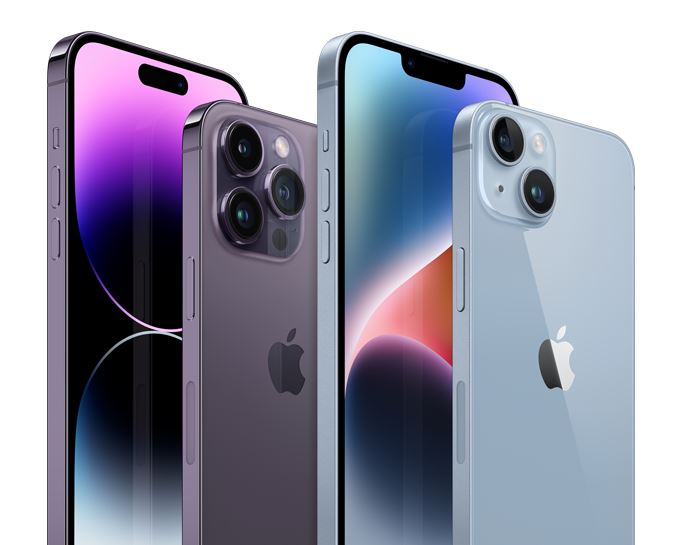Apple has finally opened up and officially introduced the next generation in its famous series of smartphones, which is the iPhone 14. This comes after all the speculations and leaks that have been going around building up to today. Don’t worry if you were unable to attend the event; we’ve summarised all you need to know about the iPhone 14 below for your convenience.
You probably anticipated this, but the general layout of the phone hasn’t changed all that much at all. It still has its shiny glass back, its straight metal edges, and two to three cameras in the rear, depending on the model. The phone’s body, on the other hand, is noticeably more robust compared to its predecessor. Because to the increased thickness, the cameras do not stick out nearly as much as they did on the iPhone 13, but regrettably, due to this little change, you won’t be able to use the phone cover that you had previously used for the iPhone 13.
If we go to the front of the iPhone, we can see that Apple has finally removed the dreaded notch, at least partially. The notch will no longer be present on the Pro and Pro Max, replacing it with a pill-shaped cutout that will house the front-facing camera as well as the Face ID sensors. Despite this, both the standard model and the Plus version retain the notch. Additionally, the new Plus model will feature a display that is 6.7 inches, which means that the size discrepancies between the Pro and Pro Max will be replicated in both the basic model and the Plus model.
The new smartphones will also come equipped with Apple’s proprietary Lightning connector, making it very probable that this will be the final iPhone to use this connection before Apple transitions to the USB-C standard.
To get into a little more detail regarding the cameras, Apple has decided to keep the same dual camera arrangement that gives 12 megapixel sensors in the entry-level variant of the iPhone 14. Apple has increased the performance of its camera sensors in low light situations by using a component that it calls the Photonic Engine. While the Pro and Pro Max will have the standard three-camera arrangement, providing the phones a wide, ultrawide, and telephoto lens much as they did the previous year, the Pro will also gain an improved low-light performance. Despite the fact that all of this seems extremely identical, there is one significant difference: the primary camera has 48 megapixels.
Apple is increasing the primary camera sensor on the Pro and Pro Max to 48 megapixels with this update. This upgraded sensor for the primary camera is also capable of capturing video in 8K resolution. In addition, Apple has enhanced the front-facing cameras of all of its models, making them more suited for taking selfies.
Moving on to the components that are built in, both the iPhone 14 Pro and the iPhone 14 Pro Max are driven by a processor manufactured by Apple called the A16 Bionic. The A15 Bionic, which can also be found in the iPhone 13, is used in place of it in the basic model and the Plus variant of the iPhone. Apple has not provided an explanation as to why the business does not use the A16 processor in all of its models; nonetheless, the present worldwide scarcity of chips may have something to do with the decision.
Apple came up with an innovative solution for the camera cutout that resembles a pill on the iPad Pro and iPad Pro Max. The firm decided to create a feature out of it, which Apple refers to as Dynamic Island, rather than just keeping it in its current state. In order to display certain alerts, this function causes the pill-shaped cutout to grow outward.
Displays are another component that will not be seeing significant development compared to the last generation. The display on the two less costly variants will have a refresh rate of 60Hz, while the display on the two more expensive models will have a refresh rate of 120Hz. Each phone continues to use an OLED screen and maintains the same resolutions as the model from the previous year. On the other hand, the ten-inch iPad Pro and the thirteen-inch iPad Pro Max both boast a brightness of 2,000 nits, making them twice as bright as the iPhone 13.
Other notable features include a maximum storage capacity of 1 terabyte for the Pro and Pro Max models, a facial recognition system called Face ID, Dolby Vision for the Pro and Pro Max models, MagSafe charging and accessories, action mode (video stabilisation), wireless charging, support for 5G networks, crash detection, an SOS signal transmitted via satellite, and the ability to have an always-on display.
At long last, the price at which these various products are going to be offered for sale has been determined. According to rumours, Apple will maintain its customary pricing structure for the iPhone 14, with the basic model costing $799 and the larger Plus variant being offered for $899. The Pro and the Pro Max will both be available for the price of $999, while the Pro Max will cost $1,099.
If you are thinking about purchasing an iPhone 14 for yourself, there will be five colour options available for the basic model as well as the Plus model. These hues are Midnight, Starlight, blue, Product (red), and white. Space Black, gold, silver, and deep purple are the colours that are available for the Pro and Pro Max models. Beginning on September 9, you’ll be able to place preorders for the iPhone 14, iPhone 14 Pro, and iPhone 14 Pro Max, or you may wait until September 16 to purchase them in retail stores. You may place your pre-order for the iPhone 14 Plus at any time today, but you won’t really be able to purchase it until October 7th.

